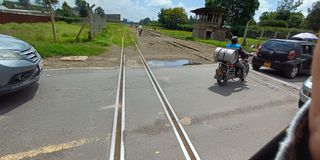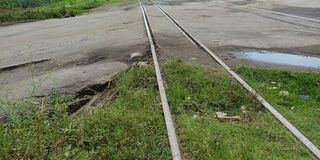Naivasha train, bus crash exposes Nakuru’s neglected transport system

The wreckage of the Kenya Pipeline Company Courtesy bus involved in an accident with a train at Morendat, Naivasha.
A dark cloud continues to hang over Nakuru as locals try to come to terms with what happened on August 7.
Nine people died and many more were injured following a devastating accident at Morendat Junction in Gilgil Sub-County, where a company bus collided with a freight train.
According to Naivasha Police Commander Anthony Keter, the bus was carrying workers from the Morendat Training and Conference Centre, run by the Kenya Pipeline Company (KPC), to Naivasha after their shift.
James Warui, the hospital's medical superintendent, said that two out of the 18 workers taken there had died.

Railway line across the road near KFA in Nakuru.
The remaining patients were transferred to Nairobi Women’s Hospital (14) and AIC Kijabe Hospital (1).
The accident has left residents questioning whether the tragedy could have been avoided if proper road safety measures had been put in place.
Nakuru, for instance, is a city strategically located to serve the northern corridor, with a railway line passing through it.
However, what happens when a railway line cuts through a road used by motorists and the intersection bears no safety measures?
The railway line runs through Nakuru, intersecting several busy roads where motorists often have to cross level crossings.

Railway line across the road heading to industrial area in Nakuru.
Free Area and Section 58 are among the most frequently used spots, particularly by those heading towards Kinuthia Mbugua Road, the Free Market or residential areas such as Naka Estate.
Another key crossing is located at KFA, along the route to Kabarak Road. This section is known to cause traffic jams occasionally, especially during peak hours.
The most problematic crossing, however, is the one leading to the industrial area. The road here is poorly maintained and pot-holed, forcing drivers to manoeuvre carefully while crossing the railway line.

Railway line across the road heading to industrial area in Nakuru.
This causes confusion and delays, as vehicles travelling in the opposite direction are forced to wait for others to cross first.
Worryingly, many of these crossings lack proper signage or barriers to alert motorists to oncoming trains. This significantly increases the risk of accidents, particularly for those who may not exercise extreme caution.
Nakuru Traffic Enforcement Officer, Allan Ogolla, emphasises that motorists should take personal responsibility when crossing a railway line.
"Just as pedestrians should exercise caution when crossing the road, motorists should approach railway crossings with caution and begin slowing down as soon as they see a railway line," he says.
He says that motorists should remember the 'Stop, Look, Listen' rule: drivers should stop at least five metres from the track, roll down their windows to listen out for any approaching trains and look both ways along the track before attempting to cross.
Mr Ogolla says that normally the train is supposed to sound its horn from a distance to notify motorists, which gives them enough time to stop. They should never race against the train.
Above all, he reminds motorists that they must always be sober while driving, especially when approaching critical points such as railway crossings.
"Being alert ensures better decision-making and helps avoid preventable accidents," he notes.
He also urged Kenya Railways to ensure that railway crossing signs are erected ad different intersections.
